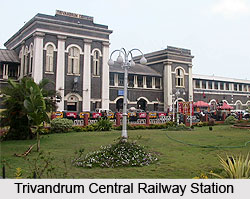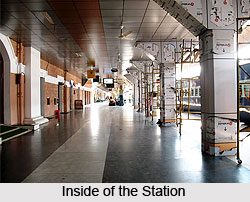 Trivandrum Central has achieved the honour of being the biggest railway station in Kerala as well as one of the significant rail hubs in South India. Trivandrum Central railway station is well connected with major parts of India. The building of the station is considered a landmark of the city. It was built during 1931 in initiation by the Maharajah of Travancore. The construction of this station building took place without using any bricks. The station building was made entirely of rock.
Trivandrum Central has achieved the honour of being the biggest railway station in Kerala as well as one of the significant rail hubs in South India. Trivandrum Central railway station is well connected with major parts of India. The building of the station is considered a landmark of the city. It was built during 1931 in initiation by the Maharajah of Travancore. The construction of this station building took place without using any bricks. The station building was made entirely of rock.
In 2004, a second terminal was opened at the Trivandrum Central railway station in order to manage the increasing traffic that the station was experiencing for last few years. This newer part of the station is completely Wi-Fi enabled. Like other railway stations, the Trivandrum Central railway station has book-shops, restaurants, accommodation, Internet browsing centres and even a necessary commodities shopping mall. In 2005, a second satellite station was opened near the International Airport at Kochuveli. Trivandrum Central railway station is the second longest train route in the world, from Kanyakumari to Jammu.
Trivandrum Central railway station on an average daily caters to 200,000 passengers. Like other major railway stations, Trivandrum Central railway station also has facilities like- book stalls, rooms for daily rent, rest rooms, etc. Some new facilities are being incorporated in the railway station like- air-conditioned dormitory, improved and extended parking and new pedestrian entry. The parking area is about 5,500 m². An additional 400 m² covered area has been added to the parking area.
 Trivandrum Central railway station is updated with modern security gadgets. The station has also accomplished the honour of installing video surveillance system. For upgrading the security and for supervising the movement of passengers arriving at the station, the Networked electronic surveillance system has been installed in the station. The station was constructed with extreme foresight. This prevision was incorporated by Maharajah of Travancore. As Trivandrum was a branch line station, the Maharaja instructed to build the station at par with the counterparts in other major cities of India.
Trivandrum Central railway station is updated with modern security gadgets. The station has also accomplished the honour of installing video surveillance system. For upgrading the security and for supervising the movement of passengers arriving at the station, the Networked electronic surveillance system has been installed in the station. The station was constructed with extreme foresight. This prevision was incorporated by Maharajah of Travancore. As Trivandrum was a branch line station, the Maharaja instructed to build the station at par with the counterparts in other major cities of India.
In the first phase in 1931, Trivandrum Central railway station was built to handle just two departures per day. But today it handles more than 30 departure per day. Since the last sixty years, the station is experiencing a boom in the passenger traffic. But without much of alteration of the main structure, the station manages traffic and passengers with ease. In the initial period the station had only one platform. But today it has eight platforms. The station features 8 platforms to manage long distance trains and short distance trains. To the other side of the main entrance there is a second terminal. The train care centre functions adjacent to the second terminal.
Recently, a decision was taken by the Indian railways to upgrade the Trivandrum Central railway station to world-class standards. In December 2006 the Union Minister for Railways, Lalu Prasad Yadav laid the foundation stone for the expansion and modernisation of the station. It has been estimated that more than Rs.100 crores will be needed for the first phase of the project. A new complex of the railway station will be built with a built-up area of 1,000,000 square feet. All modern facilities will be incorporated in the station, including an office and commercial complex. Another proposal to set up a suburban terminal at Nemom or Putharikandam maidan is also in the pipeline. It is calculated that since the project is a massive one only a syndicate would be able to take up the expansion project of Trivandrum Central















